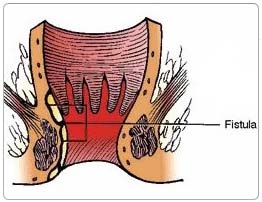What is it?
An anal fistula is a narrow tunnel running from the skin near the back passage and opening into the back passage higher up. It often shows up after there has been an abscess near the back passage.
The Operation
The roof of the fistula is cut away. This changes it from a tunnel into a trench. The trench becomes shallower as it heals, and ends up as a flat scar after a month or two. The operation can either be done as a day case, which means that you come into hospital on the day of the operation and go home the same day, or as an in-patient case, which means spending one or two nights in hospital.
Any Alternatives

You can leave things as they are. This means that the fistula will carry on discharging. You may well get more painful abscesses. The condition is not dangerous, but can be a great nuisance. Antibiotics do not make the track close off. Sometimes the tracks are very deep, and need more than simple coring out at a later date. The surgeon may only find this out when he examines you under anaesthetic. If this happens, he will talk to you about what to do next, after you wake up. Heat treatment and laser treatment do not work.
Before the operation
You may already be in hospital. If not, stop smoking and get your weight down. (See Healthy Living). If you know that you have problems with your blood pressure, your heart, or your lungs, ask your family doctor to check that these are under control. Check the hospital's advice about taking the pill or hormone replacement therapy (HRT). Check you have a relative or friend who can come with you to hospital, take you home, and look after you for the first week after the operation. Bring all your tablets and medicines with you to hospital.
On the ward, you may be checked for past illnesses and may have special tests, ready for the operation. Many hospitals now run special preadmission clinics, where you visit for an hour or two, a few weeks or so before the operation for these checks.
After - In Hospital
The wound has a dressing probably held on with elastic netting pants. There may be some staining with old blood during the first 12 hours. There will be some yellowish discharge from the wound for a week or more. This will lessen as the wound heals. There is some discomfort on moving rather than severe pain. You will be given tablets or injections to control this as required. Ask for more if the pain is still unpleasant.
By the end of one week the wound should be virtually pain-free. A general anaesthetic will make you slow, clumsy and forgetful for about 24 hours. Do not make important decisions, drive a car, use machinery, or even boil a kettle during that time. If your operation is a day case, you should feel fit enough to go home after an hour or two on the ward. If your operation is not a day case, you will be expected to get out of bed the day after operation despite the discomfort. You will not do the wound any harm, and the exercise is very helpful to you. The second day after the operation you should be able to spend most of your time out of bed and in reasonable comfort. You should be able to walk slowly along the corridor. You can wash the wound area as soon as the dressing has been removed. Soap and tap water are entirely adequate. Salted water is not necessary. The discomfort of the operation can make it difficult to pass urine and empty the bladder. It is important that your bladder does not seize up completely. If you cannot get the urine flowing properly after 6 hours, contact the nurses or your doctor. Some hospitals arrange a check up about one month after you leave hospital. Others leave check-ups to the General Practitioner. The nurses will advise about sick notes, certificates etc.
After - At Home
You are likely to feel tired and need rests for a week or so. You will gradually improve so that by the time a month has passed you will be able to return completely to your usual level of activity. The wound is always a bit moist for 3 to 6 weeks. There is likely to be a discharge of yellow matter and for a week or so even some dark blood. Sometimes a deep fistula is slower to heal than normal. You need to be patient. Opening your bowels becomes rapidly easier particularly if you take a laxative. DO NOT however take bran or a high fibre diet until the back passage is pain-free in case you end up with a blockage. Occasionally you may notice difficulty controlling the wind or even the motion through your back passage. This improves after a week or two. You will need to have the wound dressed by the district nurses or the hospital nurses until the wound has firmly healed. This may take a month or more. You can drive as soon as you can make an emergency stop without discomfort in the wound, i.e. after about 10 days. You can restart sexual relations within a week or two, when the wound is comfortable enough. You should be able to return to a light job after about 2 weeks, and any heavy job within 4 weeks.
Possible Complications
Complications are rare and seldom serious. Sometimes the control of wind or motions is weakened. The chance of the fistula coming back again is about 1 in 10. If there is a very deep fistula, you will need a different treatment, which you will be informed about. Rarely, the fistula is a sign of inflammation higher up the bowel. You may need hospital tests for this.





